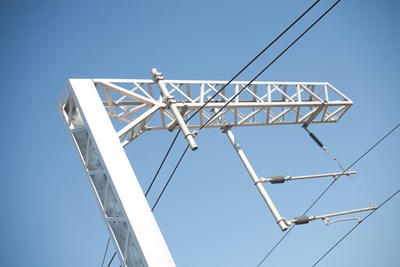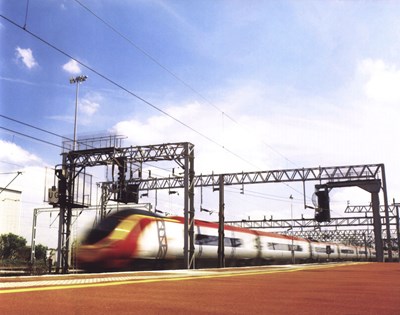Tuesday 20 Sep 2011
NETWORK RAIL CHIEF HOPES ELECTRIFICATION PLANS WILL SPARK INTEREST IN ELECTRICAL ENGINEERING GRADUATES
- Region & Route:
- National
More than 5000 graduates applied for a place on the 2011 Network Rail graduate training scheme – more than double the amount in 2008.
Today, applications open for around 100 places for the 2012 scheme. With the company receiving the green light from government to electrify hundreds of miles of track on the Great Western main line from London to Cardiff and in the north west of England, Network Rail’s chief executive David Higgins is hopeful that they can attract the very best young minds in this specialist field. A recent skills report by the Institution of Engineering and Technology found that 23% of British electrical engineering employers have experienced problems in recruiting engineering graduates.

Commenting on this, David Higgins said: "While we've had unprecedented levels of applications across the board, we've struggled to attract a great number of candidates for our electrical engineering graduate scheme. We understand that other sectors can be attractive but we need to shout louder about the exciting opportunities and challenges that lie ahead for electrical engineers as we develop and improve the network including our plans for electrification.
"We're delivering a vital public service used by more than three million people every day to get to work, home, for business and leisure. A successful railway helps drive a thriving economy and we have big plans to expand it and make it even better – today’s graduates can be part of that future."
Paul Davies, IET Head of Policy, said: "Our research clearly shows that there are opportunities out there for all engineers, including recent graduates. With many exciting railway infrastructure projects in the pipeline, now is a hugely exciting time to consider electrical engineering. Those considering a career as an engineer should take note that engineering employers, such as Network Rail, offer well paid and rewarding jobs for qualified graduates."
Akthar Hussain, who is on the electrical engineering graduate scheme at Network Rail commented on his experience: "My first placement at Stratford in London brought all sorts of unexpected challenges. When we needed to discuss security cameras, I organised and hosted a meeting with senior managers and stakeholders. I enjoyed challenges in telecoms, signalling and played a role in increasing line capacity. On a typical day at Stratford there are 40,000 people using the station. When the Olympics gets going there will be 120,000. The decisions I’ve made so far will make a real contribution and I’m so proud of that. I love pushing myself forward in such a complex organisation.”
Whilst at Network Rail there are many engineering opportunities, there are also roles in network operations, finance, information management and commercial property - Network Rail is one of the largest land owners in Britain.
Robin Miedzybrodzki is on Network Rail’s civil engineering scheme as well as training to compete in the 2012 London Olympics. Commenting on his double life and how he’s preparing for the Games, Robin said: "The partnership I have with Network Rail allows me to develop my engineering skills while also providing the flexibility to train full time for beach volleyball and compete internationally for Great Britain.
"My playing partner, Tom Lord, and I are currently competing on the FIVB World Tour, CEV Challenger Tour, and the Volleyball England Beach Tour and these competitions are vital for our team as we aim to gain Olympic qualification points and develop our game to a level so to produce a world class performance for the 2012 Games. With the funding cuts from UK sport in 2010, Network Rail’s support has been absolutely crucial in keeping my Olympic dream alive."
Kate Anderson, who joined the Network Rail graduate scheme in 2004 is now station manager at King’s Cross in London, which handles 25m people’s journeys every year. She said: "When I was at university, I knew I wanted to be a manager, I just didn’t know of what. I was looking at retail but after seeing Network Rail at a careers fair I realised that you could do almost anything on the scheme. It was the only scheme that offered that freedom, and I thought if I can’t get a great job there, I won’t be able to do it anywhere.
"Managing King’s Cross is like running your own business. I love having that ‘I did that’ effect. Every day I get to see the result of my work."
Notes to editors
Network Rail Graduate scheme
Join us and you’ll be working on projects that will literally change the shape of the nation. You’ll receive:
- Salary: £24,500
- Inner London salary: £26,900
- Employees working at a Network Rail location within a 16-mile radius of Charing Cross.
- Outer London salary: £25,890
- Employees working at a Network Rail location over 16 miles and up to 40 miles radius of Charing Cross.
- Welcome bonus: £3,000
Visit http://careers.networkrail.co.uk/graduates.aspx
Background on electricity use and electrification:
Network Rail operates extensive high voltage & low voltage electrical networks across Britain and uses 3500 GWhrs of electricity per year, making us the second largest user of electricity in the country.
Approximately 40% of the UK rail network is currently electrified. Of this, two thirds is equipped with overhead lines, whilst the remainder of the system is third rail.
The following routes are currently electrified:
· The West Coast Main Line
· East Coast Main Line
· Great Eastern Main Line
· Part of the Midland Main Line (south of Bedford)
· Great Western to Airport Junction (west London)
· Most of London commuter network (Kent, Sussex, Wessex to Portsmouth and Weymouth), Merseyside and parts of the suburban networks of Birmingham, Glasgow, Leeds and Manchester. The route from Newcastle to Sunderland is electrified at 1500V DC for the Tyne and Wear metro trains, which share the route.
In addition, Network Rail has completed electrification for Airdrie – Haymarket as part of the Airdrie-Bathgate scheme, and also has funding in CP4 to deliver a scheme for Barnt Green to Bromsgrove (West Mids).
Operational benefits
· Reduces rolling stock operating costs
· Reduction in infrastructure operating costs (track wear and tear)
· Increase in rolling stock availability
· Reduction in vehicle leasing costs
· Cost savings to freight operators (fuel costs)
· Increase in availability of diversionary routes
· Passenger rolling stock replacement
· Security of energy supply (oil price fluctuations)
Passenger benefits:
· Reduced journey times through quicker acceleration and shorter stopping distances, particularly for suburban services with frequent stops (ATOC estimates that journey time savings are in the region of a quarter of a minute for typical suburban services and half a minute for long distance services.
· Station ambience: electric trains create less noise, and don’t emit exhaust fumes
· Ride quality: diesel multiple unit trains with under floor engines can make journeys a rumbly affair
· Reliability: electric trains generally have a lower failure rate than diesel equivalents, with electric trains twice as reliable (in miles per breakdown terms)
· Reduction in rail replacement services (buses) – more diversionary routes will reduce the need to revert to buses
· New journey opportunities: if electrification is combined with service recasts, it could potentially provide new through journey opportunities.
· Additional seating capacity: on long distance high speed routes, where a diesel train with a separate power car would operate, electrification schemes eliminate the need for a diesel power car. As a result, electric trains on such routes generally provide additional passenger seating capacity within the same overall train length. For example, the two end vehicles of class 390 (Pendolino) trains contain a total of 64 seats.
Capacity Benefits
· In the case of freight services, the ability to haul greater trailing loads will reduce the number of freight paths needed freeing up capacity.
· The superior performance of electric traction can provide significant journey time savings.
Contact information
Passengers / community members
Network Rail national helpline
03457 11 41 41
Latest travel advice
Please visit National Rail Enquiries
Journalists
Network Rail press office - National
020 3356 8700
mediarelations@networkrail.co.uk
About Network Rail
We own, operate and develop Britain's railway infrastructure; that's 20,000 miles of track, 30,000 bridges, tunnels and viaducts and the thousands of signals, level crossings and stations. We run 20 of the UK's largest stations while all the others, over 2,500, are run by the country's train operating companies.
Usually, there are almost five million journeys made in the UK and over 600 freight trains run on the network. People depend on Britain's railway for their daily commute, to visit friends and loved ones and to get them home safe every day. Our role is to deliver a safe and reliable railway, so we carefully manage and deliver thousands of projects every year that form part of the multi-billion pound Railway Upgrade Plan, to grow and expand the nation's railway network to respond to the tremendous growth and demand the railway has experienced - a doubling of passenger journeys over the past 20 years.
Follow us on Twitter: @networkrail
Visit our online newsroom: www.networkrailmediacentre.co.uk


